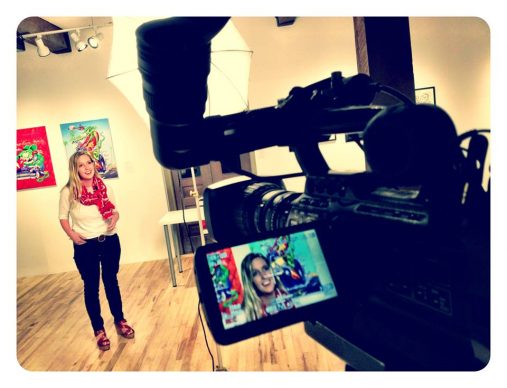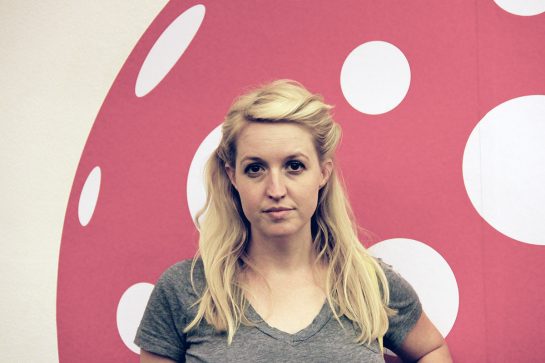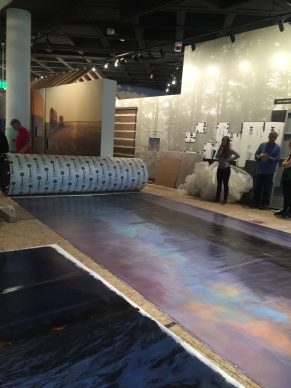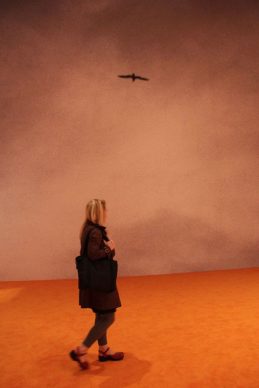As the Global Acquisitions Curator for Art for the Church History Museum, Laura Allred Hurtado has a unique understanding of how art impacts our worship. She also understands how vital it is to increase the representation and breadth of women in our artwork, and she has made some revolutionary strides in rectifying this dearth that impact our most mainstream practices.
You currently work as the Global Acquisitions Curator for Art for the Church History Museum. How did you get involved in the arts, and what led you to where you are today?
I grew up in Los Angeles, which is a city packed full of museums and culture. When I was younger, we spent summer afternoons going on “adventure days.” My mom would take a van load of grubby pig-tailed children (hers and many spares), out of the suburbs and into the city to visit art museums, often landing at the Los Angeles County Art Museum, a huge complex of several buildings packed full of a large and diverse collection. My mom is an artist and had art books throughout the house and was very fond of Mary Cassatt of whom she replicated in her own work. Both my parents are passionate people who are interested in other cultures. They traveled a lot and lived aboard. I was born in Bogotá, Colombia. So I think a passion for art and ideas comes from both of them.
My senior year, I saw a William S. Burroughs exhibition at LA Museum of Contemporary Art (MOCA). At the time, I was obsessed with beat poets, so Burroughs was someone I was familiar with and whose practice seemed more accessible (at least in terms of timeline) than French Impressionism. One piece, in particular, stood out. It was an installation of a plywood board shot many times over until the center was missing. It was, under any other circumstance, a discarded piece of trash, something to be found at a shooting range. But, within the context of the museum, it was suspended with care from the ceiling and stood about four feet in front of the wall and hung at body height. It was perplexing, complicated, and tremendously smart. Burroughs, as you may know, (accidentally) shot and killed his wife while playing William Tell and the piece had the memory of her body and the shadow of that violent act implicit in it. And there was something significant about standing there, as a witness to a crime scene, looking at the shards of wood fibers, splitters, fragments, explosions, that was really transformative for me.

I went to BYU and graduated with a degree in Art History and Curatorial Studies and graduated in 2001. I married my sophomore year and by May of 2002, my son was born. I was 22 at the time. Your first child is like a hurricane. It totally changes your identity and at times, it just felt overwhelming to me. I acclimated, got my bearing, dove in deep and four years later, I had Stella. I found staying home very rewarding, but I also became restless. I found it hard for me to measure personal success when I stayed home. It was amazing to watch my children grow and accomplish so many things. But I felt like I was floundering personally. I went back to school to get my master’s degree at the University of Utah in Art History and Visual Studies when Stella was 2. I was lucky enough to get a scholarship and the funding included a stipend that was enough to cover child care. After graduate school, I worked as an adjunct instructor at the University, then worked at the Utah Museum of Contemporary Art as Curator of Education. I started working for the Church History Museum in January 2013. When our daughter Ruby was born in 2014, I kept working full time.
What was your focus in graduate school?
I focused on contemporary art with an emphasis on works that grappled with themes of feminism, gender, and identity construction. I wrote about an exhibition at the Brooklyn Museum called Global Feminisms, curated by Maura Riley that, with startling noteworthiness, included several works on motherhood. I contrasted those images with 1970s visual representations of motherhood, specifically Judy Chicago’s Dinner Party, which is the central piece for which the Sackler Center for Feminist Art at the Brooklyn was built to hold. I was interested in how these images differed and how they evolved. A lot of my research ended up being about how contemporary feminist practices that engaged with parenthood, as subject manner, explored the experience in significant ways. Often, the works, in the exhibition, were about reclaiming the space of motherhood, putting a stake in the ground, challenging Madonna type idealism that shrouds and haunts all representations of motherhood and then interrogating it, recoding it, in philosophical, and at times, political ways.
What role do you think art plays within Mormon culture and how have you tried to enhance that role?
There is a very limited list of canonical Mormon art that you see on the walls of almost every meetinghouse. Distributed through the Gospel Art kit, it’s limited and largely illustrative. Our chapels, with some noteworthy exceptions, are quite bare. Visually, it’s iconoclastic, striped of “graven images.” So, there is, I believe, a kind of (inherited) anxiety about religious images for Mormons. And in general, it’s difficult, I think, for leaders, to want to include artwork that is multivalent. There is a feeling that the message must be clear. So, Christ, has comes to be known through Del Parsons, via inclusion of his painting Christ in the Red Robe being included in mass printings of the Book of Mormon and hung on the walls in homes and in primary rooms throughout the world.

Such mass reproduction seems to fix the image of Christ, even on a subconscious level. You bring a certain weight or meaning or burden to images because they serve as conduits to belief. Some of the projects I’ve tried to implement at the Church History Museum challenge that paradigm. Personally, I like images where Christ’s back is turned and you can’t see His face, in part, because it allows such a loaded and iconic figure to be sorted out on a personal level for the viewer. I worked with J. Kirk Richards on a project called “The Christo Series” which is a single work of art that is made up of 150 paintings of various sizes of Christ. In some, Jesus is very abstracted and obscured, but I like this version of Christ because it mirrors the terrestrial fog in which we access Christ here on earth.
I’ve tried to challenge that paradigm through my collecting practices as well. Luckily, there is a lot of freedom within the acquisition process at the Church History Museum. I’ve been able to collect a lot of things that have surprised me. I’ve tried to expand the museum’s field of vision largely because the dictum of the church history department is to collect, preserve, and share. If we’re going to collect, preserve, and share the cultural legacy of the LDS people, then we need to think outside of the standard, gospel art kit. LDS artists are doing all kinds of things that explore their faith and the Mormon experience. To give a music analogy: The Mormon Tabernacle Choir is appropriate as an LDS cultural signifier but so is Imagine Dragons and so are The Killers. I’m negotiating those artistic boundaries and negotiating ways in which we can be inclusive when thinking about Mormon aesthetic practices.
What role does art by and about women play in your collection and exhibition practices?
Early in my church employment, I read a short story by Carol Lynn Pearson called “Walking In Pink Moccasins.” Basically, it utilizes a rhetoric that is commonly geared towards women, and gears it towards men in a painfully ironic and satirical way. It made all the more obvious to me the many ways in which we could work to be more inclusive in general as a church, and how much I need to work, on a micro level, to be more conscious in collecting practices and exhibition strategies. So, I’ve made efforts to collect works by women artists in an attempt to make some compensatory changes in the church history collection. There are many great LDS women artists so that’s been easy.
Shortly after I started working at the Church History Museum, they opened an exhibition called “100 Years of Scouting.” People have their own personal feelings about the scouting program but in general, the exhibition brought a lot of people in and from a museum exhibition building view, it was a great show. But it felt a bit unfair in terms of budget distribution and it replicated such inequalities that exist on a macro level through church programs. So, when I was asked to create an exhibition, I proposed the show “Practicing Charity: Everyday Women of God.” It isn’t a feminist show but it was an exhibition that highlighted three artists, Lee Bennion, Kathy Peterson and Brian Kershisnik, all of whom have a collective community interest and whose body of work tends to focus on the image of woman. Often times, their figures are depicted doing rather mundane, really banal things, but in the act of having them painted, in the isolation of these acts, the women seem transformed, even honored.

For example, Kershisnik’s “Bringing Food” depicts a woman holding a bowl that looks like a sacramental offering. There’s steam is coming up from the bowl, and it’s like a sacred offering. The painting captures this holy gesture—and who knows who she’s bringing food to? She could be putting it on the table for her family; She could be bringing it to a neighbor. I felt like implicit in all three of the artists’ works was the theme of glorifying the everyday and recognizing the banal as worthwhile, meaningful, important, and even sacred. This applies particularly to women’s work in the every day.
What do you think it does for us as women to see images of women in LDS visual culture?
“You can’t be what you can’t see.” I think maybe it was Marian Wright Edelman who said this. But I heard it over and over again on Mormon Feminist blogs and in my feminist readings during graduate school. Certainly, there is truth to it. Marginalized populations benefit from being seen. It helps to shape a sense of self, a sense of personhood, a sense of mattering to the world. Women have long been written out of history–it’s certainly not just a Mormon paradigm. I think there’s something really important about finding opportunities to be inclusive and looking for moments, ways and places, where the many achievements and contributions of women can be highlighted.
For example, I made a few acquisitions that have started, in part, to reshape some of the visual narratives in the conference center. One is a collection of illustrations of women from the bible by Kathleen Peterson, taken from the book by Mcarthur Krishna and Bethany Brady Spaling’ called Girls Who Choose God. The other acquisition is Elspeth Young’s Till We Meet Again, a depiction of Jane Manning James, who was one of the first African American converts to the church and among the first African American to settle in the western frontier of the United States. Additionally, I worked to arrange a loan of the painting She will Find what is Lost, by Brian Kershisnik. I included those two acquisitions and the loan in the conference center after working to include portraits of women auxiliary leaders there as well. Visibility matters. These stories matter.
What are some tips for incorporating art into our homes? How can we instill a love of art and visual literacy in our children?
Integrating art into our homes can be a challenge. Cost can make original art prohibitive. And yet when really great and meaningful works of art are replicated into a poster, so much of the significance is lost, and they seem to stand as shells or echoes of the original. In our family, we’ve tried to make it a priority to collect very small works that are meaningful to us.

Installing the Church History Museum’s new permanent exhibit
In terms of instilling a love of art, we certainly go to museums a lot and because I worked as a museum educator, I ask a lot of questions about what my children see and what interests them in the gallery. We had a wonderful time once at the National Gallery in London with a very well designed children’s guide. My then 10 and 6 year olds spent hours scavenging the museum, finding all of their favorite pieces, and then lying on their tummies and drawing a copy of Van Gogh’s Sunflowers. We go to lectures, gallery strolls, and exhibition openings often. We have many friends who are artists. We talk about art and have books around the house. They attend an art focused school. It is clearly a passion for me and my husband.
And yet… I’m OK if my kids don’t walk away from our family life together with a love of art. Visual literary—Yes, absolutely; Critical thinking skills—Yes, but a Love, No. It is certainly my love, but more I want them to understand that when you love someone, you support them in their interests. And my children have many interests and passions: cats, football, guitars, music, Instagram, social justice, American Girl Doll, roller skating, stuffed animals, Daniel Tiger. They love those things, so we talk about them and we spend time doing those things as well. We learn from each and from each other’s passions.

What role can art play in our spiritual development, if any? How does art inform your spirituality specifically?
If I’m feeling very unsentimental, I think of art as mere objects—things of conspicuous consumption. That’s if I’m being super nihilistic and that’s one end of the spectrum. Then, there’s this other end of the spectrum where I see an image, and it is transformative. It feels trite to say that some art speaks to your soul, but that’s kind of what happens. It communicates a truth to you that you already knew on some level or asks you a question that you were ready to be asked and have a conversation about. I think those moments of standing in awe in front of a really engaging work of art are sublime. I think that experience is probably a micro version of how you would feel in the presence of God. Most days, like many people, I’m a bit in between.
At A Glance
Name: Laura Allred Hurtato
Age: 35
Location: Salt Lake City, UT
Marital History: Married
Children: Samuel, 13; Stella, 9; Ru, 15 months
Occupation: Global Acquisitions Art Curator, LDS Church History Museum
Schools Attended: Brigham Young University, BA Art History and Curatorial Studies; University of Utah, MA Art History and Visual Culture
On the Web: http://artistsofutah.org/15Bytes/
Interview by Krisanne Hastings Knudsen
